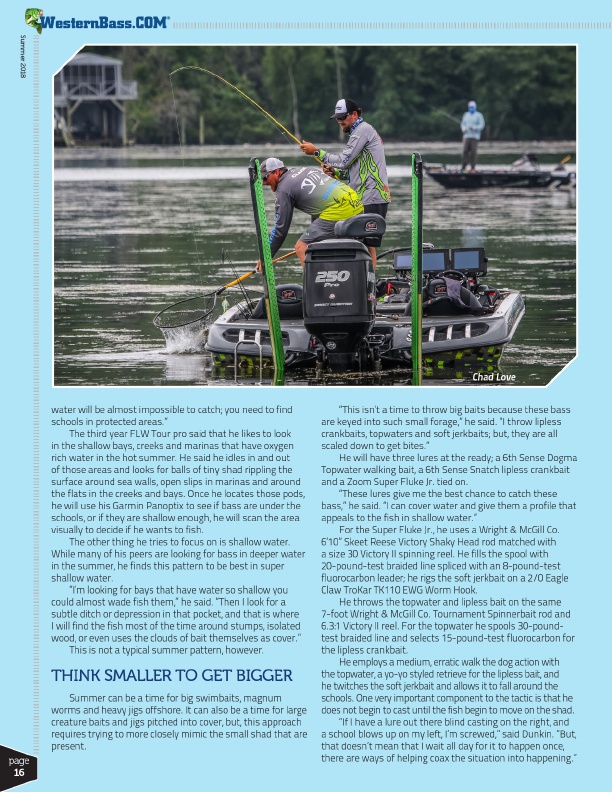
®
Summer 2018
Chad Love
page
16
water will be almost impossible to catch; you need to find schools in protected areas.”
The third year FLW Tour pro said that he likes to look in the shallow bays, creeks and marinas that have oxygen rich water in the hot summer. He said he idles in and out of those areas and looks for balls of tiny shad rippling the surface around sea walls, open slips in marinas and around the flats in the creeks and bays. Once he locates those pods, he will use his Garmin Panoptix to see if bass are under the schools, or if they are shallow enough, he will scan the area visually to decide if he wants to fish.
The other thing he tries to focus on is shallow water. While many of his peers are looking for bass in deeper water in the summer, he finds this pattern to be best in super shallow water.
“I’m looking for bays that have water so shallow you could almost wade fish them,” he said. “Then I look for a subtle ditch or depression in that pocket, and that is where I will find the fish most of the time around stumps, isolated wood, or even uses the clouds of bait themselves as cover.”
This is not a typical summer pattern, however.
THINK SMALLER TO GET BIGGER
Summer can be a time for big swimbaits, magnum worms and heavy jigs offshore. It can also be a time for large creature baits and jigs pitched into cover, but, this approach requires trying to more closely mimic the small shad that are present.
“This isn’t a time to throw big baits because these bass are keyed into such small forage,” he said. “I throw lipless crankbaits, topwaters and soft jerkbaits; but, they are all scaled down to get bites.”
He will have three lures at the ready; a 6th Sense Dogma Topwater walking bait, a 6th Sense Snatch lipless crankbait and a Zoom Super Fluke Jr. tied on.
“These lures give me the best chance to catch these bass,” he said. “I can cover water and give them a profile that appeals to the fish in shallow water.”
For the Super Fluke Jr., he uses a Wright & McGill Co. 6’10” Skeet Reese Victory Shaky Head rod matched with a size 30 Victory II spinning reel. He fills the spool with 20-pound-test braided line spliced with an 8-pound-test fluorocarbon leader; he rigs the soft jerkbait on a 2/0 Eagle Claw TroKar TK110 EWG Worm Hook.
He throws the topwater and lipless bait on the same 7-foot Wright & McGill Co. Tournament Spinnerbait rod and 6.3:1 Victory II reel. For the topwater he spools 30-pound- test braided line and selects 15-pound-test fluorocarbon for the lipless crankbait.
He employs a medium, erratic walk the dog action with the topwater, a yo-yo styled retrieve for the lipless bait, and he twitches the soft jerkbait and allows it to fall around the schools. One very important component to the tactic is that he does not begin to cast until the fish begin to move on the shad.
“If I have a lure out there blind casting on the right, and a school blows up on my left, I’m screwed,” said Dunkin. “But, that doesn’t mean that I wait all day for it to happen once, there are ways of helping coax the situation into happening.”